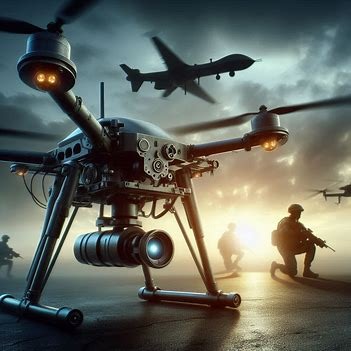
Drones: Revolutionizing Warfare and Safeguarding Nature
In the rapidly evolving landscape of modern technology, drones have emerged as transformative tools, reshaping the realms of military operations and environmental conservation. These unmanned aerial vehicles (UAVs) have not only revolutionized warfare and surveillance but have also become invaluable assets in protecting our planet’s biodiversity. This blog explores the dual role of drones in these seemingly disparate fields, highlighting their critical importance and potential for future applications.
The Vanguard of Modern Warfare
The integration of drones into military operations has fundamentally altered the nature of warfare in the 21st century. UAVs have become indispensable tools for reconnaissance, surveillance, and precision strikes, offering unprecedented tactical advantages while minimizing risks to human personnel.

One of the most notable examples of drone warfare is the MQ-9 Reaper, extensively used by the United States Air Force. This formidable UAV has played a pivotal role in numerous conflicts, including operations in Afghanistan and Iraq. Capable of long-endurance flights and equipped with advanced sensors and weaponry, the Reaper has conducted both intelligence-gathering missions and precision strikes against high-value targets.
The Israeli-made Harpy drone represents another leap in autonomous defense systems. This loitering munition can autonomously detect and engage enemy radar systems, showcasing the potential for AI-driven combat drones. Such advancements raise complex ethical questions about the role of human decision-making in warfare and the potential consequences of autonomous weapons systems.
Surveillance operations have also been revolutionized by drone technology. The RQ-4 Global Hawk, with its ability to conduct surveillance missions for up to 32 hours at altitudes of 60,000 feet, has redefined the concept of persistent aerial reconnaissance. This capability has proven crucial in monitoring potential threats and gathering intelligence in various global hotspots.
Guardians of the Environment
While drones have garnered attention for their military applications, their role in environmental conservation is equally revolutionary. UAVs are providing conservationists with unprecedented access to remote areas and offering new perspectives on ecological challenges.
In the dense rainforests of Sumatra, drones equipped with thermal imaging cameras have been instrumental in protecting endangered orangutans. Conservation drones operated by the Sumatran Orangutan Conservation Programme can detect heat signatures of both orangutans and potential poachers, allowing for more effective monitoring and protection of these critically endangered primates.
The fight against illegal deforestation has also been bolstered by drone technology. In the Amazon rainforest, drones operated by the Brazilian Institute of Environment and Renewable Natural Resources (IBAMA) conduct regular patrols, identifying illegal logging operations that would be difficult to detect from the ground. This aerial surveillance has significantly enhanced the ability to enforce environmental regulations and protect one of the world’s most crucial ecosystems.
Marine conservation efforts have similarly benefited from drone technology. In Australia’s Great Barrier Reef, researchers are using drones to monitor coral health and detect outbreaks of crown-of-thorns starfish, a major threat to coral ecosystems. The ability to rapidly survey large areas of the reef has dramatically improved response times to potential threats and enhanced overall conservation efforts.
Climate change research has also been revolutionized by drone technology. In the Arctic, drones are being used to study sea ice patterns and monitor wildlife populations. The ability to access remote and dangerous areas without risking human lives has opened up new avenues for climate research and helped scientists better understand the impacts of global warming on fragile ecosystems.
Navigating the Dual-Use Dilemma
The dual nature of drone technology – its capacity to both wage war and protect nature – presents a complex ethical and practical challenge. As we continue to push the boundaries of what’s possible with UAVs, it becomes increasingly crucial to establish robust frameworks governing their use in both military and civilian contexts.
In the realm of warfare, the advent of autonomous drones raises profound questions about the nature of combat and the role of human decision-making in conflicts. As these systems become more sophisticated, policymakers and military strategists must grapple with the ethical implications of delegating lethal force to machines.
Conversely, in environmental conservation, drones offer a beacon of hope. They provide conservationists with powerful tools to monitor, protect, and restore ecosystems that are critical to the planet’s health. The potential for drones to revolutionize our understanding of the natural world and enhance our ability to protect it is truly awe-inspiring.
As we stand at the crossroads of this technological revolution, our challenge is to harness the potential of drones for the greater good while mitigating the risks associated with their military applications. By fostering international cooperation, establishing clear ethical guidelines, and promoting responsible innovation, we can ensure that drone technology serves as a force for positive change in our ever-evolving world.
The future of drone technology, both in warfare and conservation, is bound to be marked by continued innovation and ethical deliberation. As we navigate this complex landscape, our ultimate goal should be to maximize the benefits of this remarkable technology while safeguarding against its potential for harm, ensuring that drones continue to serve as tools for progress, security, and environmental stewardship in the years to come.








